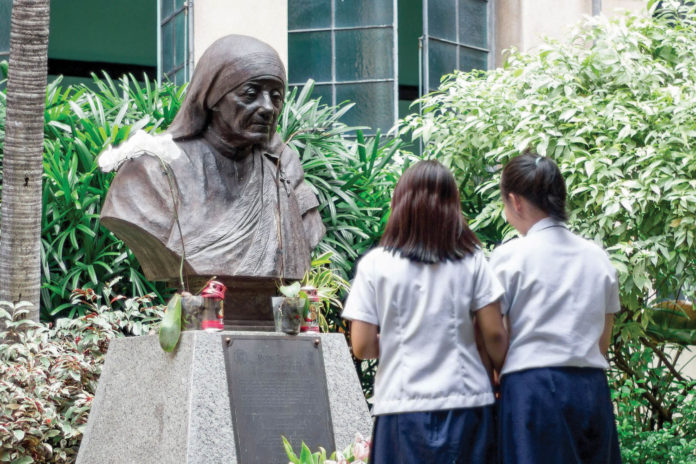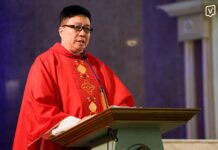MOTHER Teresa is now “Saint Teresa of Calcutta.”
Dubbed by many as the “Saint of the Gutters,” Mother Teresa was canonized last Sept. 4 by Pope Francis at St. Peter’s Square in Vatican City.
Cardinal Angelo Amato, prefect of the Congregation for the Causes of Saints, read a brief account of the saint’s life, including how she established her congregation, the Missionaries of Charity.
“Mother Teresa was tireless, dedicating herself completely to announcing the Gospel through various charitable and aid works to the needy, with no distinction of rank, religion or race,” Amato said.
Pope Francis read the official formula for canonization, which declared Mother Teresa a saint.
“We decree and define Blessed Teresa of Calcutta to be a saint, and we place her name in the catalogue of saints, decreeing that in the universal Church she is to be venerated among the saints with pious devotion,” the Pope said in Latin.
Mother Teresa’s relic, a vial of blood, was carried to the altar by two members of the Missionaries of Charity for veneration.
In his homily for the Solemn Mass, the Pope urged the faithful to emulate Mother Teresa’s smile as well as her example of humility and mercy.
“In this way, we will open up opportunities of joy and hope for our many brothers and sisters who are discouraged and who stand in need of understanding and tenderness,” he said.
The Pope treated about 1,500 homeless people from different regions of Italy to a meal after the canonization, through the Office of the Papal Almoner.
Local celebration
The sisters of the Missionaries of Charity in the Philippines, along with priests and lay faithful, gathered last Sept. 5 at the Immaculate Conception Parish in Tondo, Manila to celebrate Mother Teresa’s 19th death anniversary. They marked her feast day with a Holy Mass.
Fr. Jerome Reyes, the Mass celebrant, urged devotees to pattern their lives after the new saint.
“Mother Teresa lived her life beautifully for God. The challenge for us is to do the same,” he said.
Fr. Reyes also called on the faithful to adapt the beliefs of Mother Teresa on helping the less fortunate, saying that serving the poor is also serving Jesus.
“The life ministry of Mother Teresa was always centered on Jesus. Kung ganoon ang prinsipyo niyo sa buhay, hindi kayo mapapagod. The more you will persevere because it is Jesus, Himself, you are serving,” he added.
Miracle, criticism
Mother Teresa’s canonization came after Marcilio Haddad Andrino, a Brazilian who suffered from a viral brain infection, was miraculously healed through the saint’s intercession.
Mother Teresa made three visits to the Philippines, opening charity homes and visiting the poor. She addressed the Thomasian community during her visits to UST in 1977 and 1984.
The canonization was met with some criticism however.
Critics revived old accusations that the saint had relished on the sufferings of the poor and denied them medical care and sanitation.
They also alleged that Mother Teresa got funds from corrupt personalities and used the money for her own benefit.
The Missionaries of Charity have rejected such claims.
In a statement, the US-based Catholic League addressed claims made by a doctor in the New York Times that the congregation had unhygienic practices.
“[O]ver their decades of service, the mortality rate of those in the care of the nuns dropped precipitously; we would not expect such results if the care were substandard. Moreover, independent assessments of the quality of service, provided by Dr. Robin Fox, praised the sisters for their cleanliness,” it said.
The Catholic League said Mother Teresa earned her sainthood.
“If ever there were an altruist, it was Mother Teresa. She selflessly gave of herself for decades, helping the sick and dying, picking them up off the street, securing medicinal care, and comforting them in their closing days. And she never asked for anything in return,” the group said.
“Those she ministered to were the most destitute of the destitute: children who survived abortions, the malnourished, lepers, AIDS patients, the physically and mentally handicapped, elderly cripples—she never turned anyone away. Indeed, she implored those who would abandon the dispossessed—this included hospitals—to ‘give them to me.’”
Mother Teresa’s critics were mostly militant atheists and radical socialists who saw her as a threat, the group pointed out.
“She was a threat to the worldview that holds that religion is inimical to freedom, and faith-based programs for the poor are an obstacle to statist prescriptions. Indeed, she represented a target that was so rich, so big, it was irresistible,” the Catholic League said.














